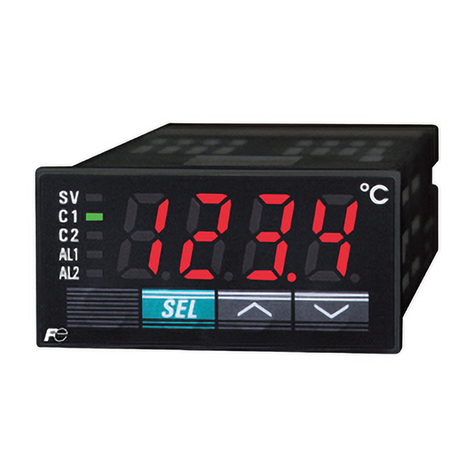– 1 –
Thank you for your purchasing “Fuji DIGITAL THERMOSTAT.” Please check that the product is exactly the
one you ordered and use it according to the following instructions. (Please refer to a separate operation
manual for details.) Dealers are cordially requested to ensure the delivery of this Instruction Manual to hands
of the end-users.
NOTICE
The contents of this document may be changed in the future without prior notice.
We paid the utmost care for the accuracy of the contents. However, we are not liable for direct and indirect
damages resulting from incorrect descriptions, omission of information, and use of information in this docu-
ment.
Instruction Manual
DIGITALTHERMOSTAT
Model : PAS3 INP-TN1PAS3-E
Head Office
11-2, Osaki 1-chome, Shinagawa-ku, Tokyo, 141-0032 Japan
Sales Div. International Sales Dept.
No.1, Fuji-machi, Hino-city, Tokyo, 191-8502 Japan
Phone : +81-42-585-6201, 6202
Fax : +81-42-585-6187, 6189
http://www.fic-net.co.jp
Instruction Manual
Details for operation method and the related documents
Before using the controller, check if the type and specifications are as ordered.
Check that all of the following accessories are included in the package box.
· Digital thermostat mian unit 1 unit
· Instruction manual 1 copy
· Mounting bracket 1 pce.
· Watertight packing 1 pce.
· Thermister sensor (only for the type that the input signal is thermistor)
Note: The provided thermistor sensor is the sensor dedicated to this equipment.
Check of specifications and accessories
Safety Precautions ............................................... 2
For normal usage ................................................. 7
1. Installation/mounting ...................................... 8
2. Wiring............................................................. 9
3. Usage............................................................. 10
4. Operation ....................................................... 11
5. Display shifting method .................................. 12
6. Functions ....................................................... 13
7. List of parameters .......................................... 15
8. Alarm function ................................................ 17
9. Error indications ............................................. 19
Specification......................................................... 19
PAS3 Model Code ................................................ 19
CONTENTS
Contents
Operation method
Details of alarm functions
Specifications
No.
ECNO:410
TN513439-E
ECNO:1142
Name
DIGITAL THERMOSTAT OPERATION MANUAL
DETAIL DESCRIPTION ABOUT FUNCTIONS
OF ALARM OF DIGITAL THERMOSTAT
Catalogue




























